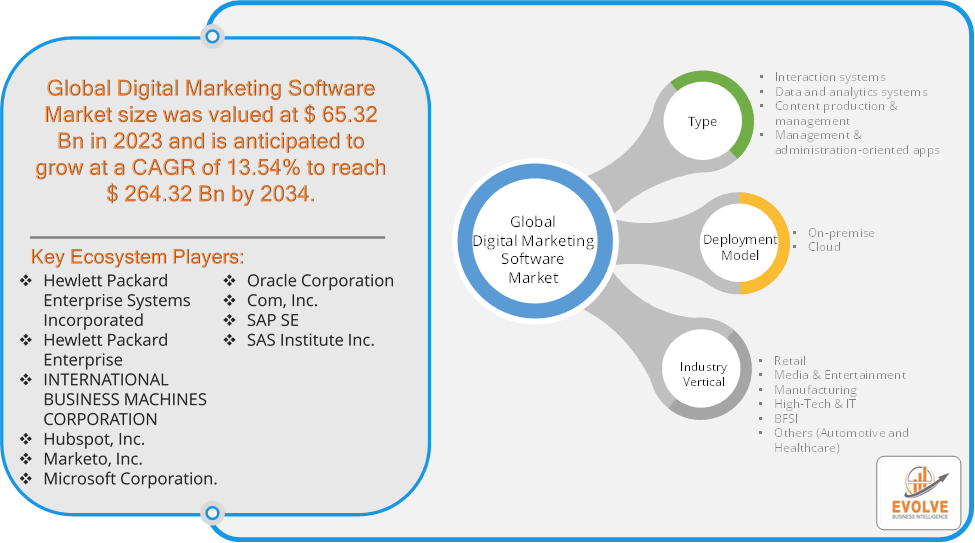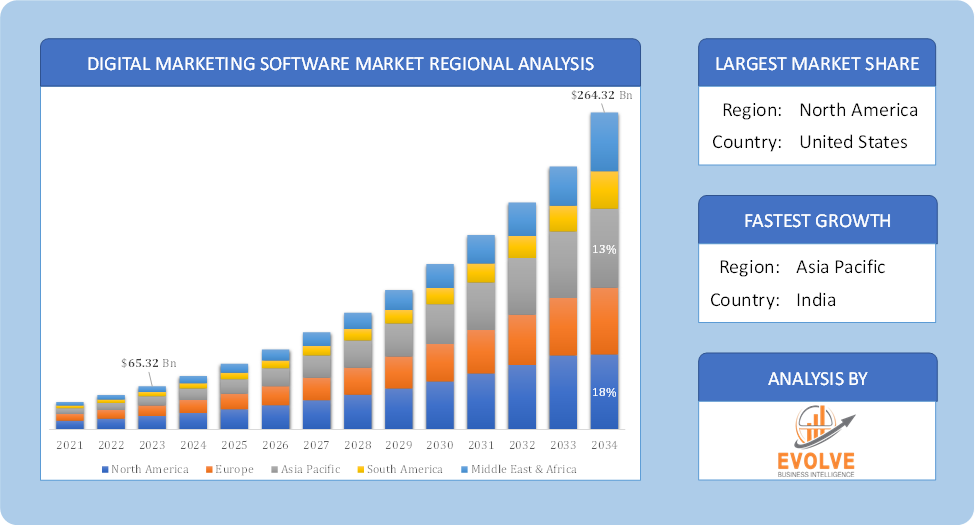Digital Marketing Software Market Overview
The Digital Marketing Software Market size accounted for USD 65.32 Billion in 2023 and is estimated to account for 75.36 Billion in 2024. The Market is expected to reach USD 264.32 Billion by 2034 growing at a compound annual growth rate (CAGR) of 13.54% from 2024 to 2034. The global Digital Marketing Software market size is expected to reach $239.18 Billion by 2028 growing at the CAGR of 21.21% from 2021 to 2028. Digital marketing software is a comprehensive and cost-effective solution that includes all the functionalities of digital marketing. With this software, companies can schedule and publish blog posts to drive traffic, manage their social media accounts to build a loyal customer base, find customers through a web search, create mobile apps to engage with them on the go, or even conduct lead generation campaigns to get more leads in your database.
Global Digital Marketing Software Market Synopsis
 Global Digital Marketing Software Market Dynamics
Global Digital Marketing Software Market Dynamics
The major factors that have impacted the growth of Digital Marketing Software are as follows:
Drivers:
⮚ Data-Driven Marketing Strategies
The marketing landscape has changed as a result of the abundance of readily available customer data. Companies are depending more and more on data analytics to help them with decision-making and marketing strategy customization. With the use of tools for data collecting, analysis, and reporting provided by digital marketing software, businesses may spot patterns, gauge the success of their campaigns, and maximize their marketing expenditures. This data-centric strategy improves personalization and targeting for customers, which eventually raises conversion rates.
Restraint:
- Data Privacy and Security Concerns
Data security and consumer privacy are becoming more and more of a worry as privacy violations and data breaches grow increasingly common. Strict laws like the California Consumer Privacy Act (CCPA) and the General Data Protection Regulation (GDPR) require businesses to abide by strict guidelines and place heavy obligations on data management and customer consent. Businesses are wary of implementing digital marketing software that gathers and uses customer data since non-compliance can lead to significant fines and harm to their brand. Some companies can be discouraged from committing fully to digital marketing campaigns because of this danger.
Opportunity:
⮚ . Expansion of Artificial Intelligence and Machine Learning
Technologies like machine learning (ML) and artificial intelligence (AI) are completely changing how marketers engage with consumers and evaluate data. These technologies can provide insights into consumer behavior, predict trends, and optimize marketing campaigns in real-time. Digital marketing software developers now have the chance to produce advanced products that provide tailored suggestions, predictive analytics, and enhanced targeting capabilities thanks to the incorporation of AI and ML. This invention has the potential to greatly increase marketing campaigns’ efficacy.
Digital Marketing Software Market Segment Overview
Based on the Type, the market is segmented based on Interaction Systems, Data & Analytics Systems, Content Production & Management, and Management & Administration-Oriented Apps. Data & Analytics Systems segment dominates, as businesses prioritize data-driven decision-making to enhance marketing effectiveness. The growing emphasis on understanding consumer behavior and measuring campaign performance drives the demand for advanced analytics tools that can provide actionable insights.
By Deployment Model
Based on the Deployment Model, the market has been divided into On-Premise and Cloud. Cloud deployment model dominates, driven by its scalability, flexibility, and cost-effectiveness. Businesses increasingly prefer cloud-based solutions for their ability to facilitate remote access, real-time collaboration, and automatic updates, making them ideal for dynamic marketing environments.
By Industry Vertical
Based on Industry Vertical, the market has been divided into Retail, Media & Entertainment, Manufacturing, High-Tech & IT, BFSI, and Others. Retail sector dominates due to its extensive reliance on online sales channels and the need for targeted marketing strategies to engage consumers effectively. The demand for personalized shopping experiences and data-driven marketing in retail continues to drive significant investment in digital marketing solutions.
Global Digital Marketing Software Market Regional Analysis
Based on region, the market has been divided into North America, Europe, Asia-Pacific, the Middle East & Africa, and Latin America. The area of North America is anticipated to dominate the market for the usage of Digital Marketing Software, followed by those in Asia-Pacific and Europe.
 Global Digital Marketing Software North America Market
Global Digital Marketing Software North America Market
North America dominates the Digital Marketing Software market due to several factors. In 2020, North America emerged as the industry leader for digital marketing solutions. North American consumers have demonstrated a significant affinity for online shopping, which is creating opportunities for online product marketing for marketers and propelling the region’s market’s future growth. It is anticipated that the Asia Pacific area would experience notable expansion. It is distinguished by a dense population, an increase in smartphones, and the deployment of high-speed internet networks. Additionally, a sizable fraction of this region’s smartphone users use social media on their smartphones.
Global Digital Marketing Software Asia Pacific Market
The Asia-Pacific region has been witnessing remarkable growth in recent years. The market for digital marketing software is expanding quickly in the Asia-Pacific area due to factors like rising smartphone use, e-commerce sector expansion, and rising internet penetration. To improve client interaction and boost sales, companies in nations like China, India, and Australia are investing more and more in digital marketing technologies. Additionally, software vendors have a lot of opportunity to customize solutions that take into account regional trends and tastes because to the region’s diversified consumer base and changing digital landscape.
Competitive Landscape
The competitive landscape includes key players (tier 1, tier 2, and local) having a presence across the globe. Companies such as Hewlett Packard Enterprise Systems Incorporated, Hewlett Packard Enterprise, INTERNATIONAL BUSINESS MACHINES CORPORATION, Hubspot, Inc., and Marketo, Inc. are some of the leading players in the global Digital Marketing Software Industry. These players have adopted partnership, acquisition, expansion, and new product development, among others as their key strategies.
Key Market Players:
- Hewlett Packard Enterprise Systems Incorporated
- Hewlett Packard Enterprise
- INTERNATIONAL BUSINESS MACHINES CORPORATION
- Hubspot, Inc.
- Marketo, Inc.
- Microsoft Corporation.
- Oracle Corporation
- Com, Inc.
- SAP SE
- SAS Institute Inc.
Key development:
In September 2023, Microsoft Corporation enhanced its digital marketing software offerings by integrating advanced AI capabilities into Microsoft Advertising, allowing businesses to optimize campaigns and improve targeting precision. Additionally, the company focused on expanding its cloud-based marketing solutions to facilitate better data analytics and customer insights for marketers.
Scope of the Report
Global Digital Marketing Software Market, by Type
- Interaction systems
- Data and analytics systems
- Content production & management
- Management & administration-oriented apps
Global Digital Marketing Software Market, by Deployment Model
- On-premise
- Cloud
Global Digital Marketing Software Market, by Industry Vertical
- Retail
- Media & Entertainment
- Manufacturing
- High-Tech & IT
- BFSI
- Others (Automotive and Healthcare)
Global Digital Marketing Software Market, by Region
- North America
- US
- Canada
- Mexico
- Europe
- UK
- Germany
- France
- Italy
- Spain
- Benelux
- Nordic
- Rest of Europe
- Asia Pacific
- China
- Japan
- South Korea
- Indonesia
- Austalia
- Malaysia
- India
- Rest of Asia Pacific
- South America
- Brazil
- Argentina
- Rest of South America
- Middle East & Africa
- Saudi Arabia
- UAE
- Egypt
- South Africa
- Rest of Middle East & Africa
| Parameters | Indicators |
|---|---|
| Market Size | 2034: USD 264.32 Billion |
| CAGR (2021-2034) | 13.54% |
| Base year | 2023 |
| Forecast Period | 2021-2034 |
| Historical Data | 2021 (2017 to 2020 On Demand) |
| Report Coverage | Revenue Forecast, Competitive Landscape, Growth Factors, and Trends |
| Key Segmentations | Type, Deployment Model, Industry Vertical |
| Geographies Covered | North America, Europe, Asia-Pacific, South America, Middle East, Africa. |
| Key Vendors | Hewlett Packard Enterprise Systems Incorporated, Hewlett Packard Enterprise, INTERNATIONAL BUSINESS MACHINES CORPORATION, Hubspot, Inc., Marketo, Inc., Microsoft Corporation., Oracle Corporation, Com, Inc., SAP SE, SAS Institute Inc. |
| Key Market Opportunities | · The changing trends of wireless communication and the increasing adoption of wireless devices and smart devices have impacted the Digital Marketing Software market growth in recent years. |
| Key Market Drivers | · The increased usage of Digital marketing including small and medium-sized enterprises has bolstered the growth of the Digital Marketing Software market value. |
REPORT CONTENT BRIEF:
- High-level analysis of the current and future Digital Marketing Software market trends and opportunities
- Detailed analysis of current market drivers, restraining factors, and opportunities in the future
- Digital Marketing Software market historical market size for the year 2022, and forecast from 2021 to 2034
- Digital Marketing Software market share analysis at each product level
- Competitor analysis with detailed insight into its product segment, Government & Defense strength, and strategies adopted.
- Identifies key strategies adopted including product launches and developments, mergers and acquisitions, joint ventures, collaborations, and partnerships as well as funding taken and investment done, among others.
- To identify and understand the various factors involved in the global Digital Marketing Software market affected by the pandemic
- To provide a detailed insight into the major companies operating in the market. The profiling will include the Government & Defense health of the company’s past 2-3 years with segmental and regional revenue breakup, product offering, recent developments, SWOT analysis, and key strategies.









